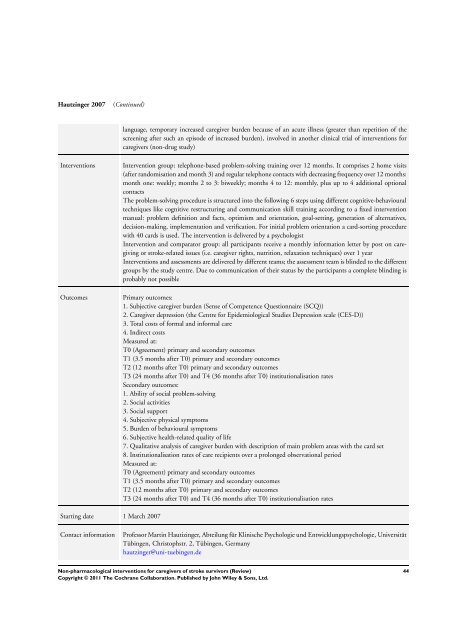Non-pharmacological interventions for caregivers ... - Update Software
Non-pharmacological interventions for caregivers ... - Update Software
Non-pharmacological interventions for caregivers ... - Update Software
Create successful ePaper yourself
Turn your PDF publications into a flip-book with our unique Google optimized e-Paper software.
Hautzinger 2007 (Continued)<br />
language, temporary increased caregiver burden because of an acute illness (greater than repetition of the<br />
screening after such an episode of increased burden), involved in another clinical trial of <strong>interventions</strong> <strong>for</strong><br />
<strong>caregivers</strong> (non-drug study)<br />
Interventions Intervention group: telephone-based problem-solving training over 12 months. It comprises 2 home visits<br />
(after randomisation and month 3) and regular telephone contacts with decreasing frequency over 12 months:<br />
month one: weekly; months 2 to 3: biweekly; months 4 to 12: monthly, plus up to 4 additional optional<br />
contacts<br />
The problem-solving procedure is structured into the following 6 steps using different cognitive-behavioural<br />
techniques like cognitive restructuring and communication skill training according to a fixed intervention<br />
manual: problem definition and facts, optimism and orientation, goal-setting, generation of alternatives,<br />
decision-making, implementation and verification. For initial problem orientation a card-sorting procedure<br />
with 40 cards is used. The intervention is delivered by a psychologist<br />
Intervention and comparator group: all participants receive a monthly in<strong>for</strong>mation letter by post on caregiving<br />
or stroke-related issues (i.e. caregiver rights, nutrition, relaxation techniques) over 1 year<br />
Interventions and assessments are delivered by different teams; the assessment team is blinded to the different<br />
groups by the study centre. Due to communication of their status by the participants a complete blinding is<br />
probably not possible<br />
Outcomes Primary outcomes:<br />
1. Subjective caregiver burden (Sense of Competence Questionnaire (SCQ))<br />
2. Caregiver depression (the Centre <strong>for</strong> Epidemiological Studies Depression scale (CES-D))<br />
3. Total costs of <strong>for</strong>mal and in<strong>for</strong>mal care<br />
4. Indirect costs<br />
Measured at:<br />
T0 (Agreement) primary and secondary outcomes<br />
T1 (3.5 months after T0) primary and secondary outcomes<br />
T2 (12 months after T0) primary and secondary outcomes<br />
T3 (24 months after T0) and T4 (36 months after T0) institutionalisation rates<br />
Secondary outcomes:<br />
1. Ability of social problem-solving<br />
2. Social activities<br />
3. Social support<br />
4. Subjective physical symptoms<br />
5. Burden of behavioural symptoms<br />
6. Subjective health-related quality of life<br />
7. Qualitative analysis of caregiver burden with description of main problem areas with the card set<br />
8. Institutionalisation rates of care recipients over a prolonged observational period<br />
Measured at:<br />
T0 (Agreement) primary and secondary outcomes<br />
T1 (3.5 months after T0) primary and secondary outcomes<br />
T2 (12 months after T0) primary and secondary outcomes<br />
T3 (24 months after T0) and T4 (36 months after T0) institutionalisation rates<br />
Starting date 1 March 2007<br />
Contact in<strong>for</strong>mation Professor Martin Hautizinger, Abteilung für Klinische Psychologie und Entwicklungspsychologie, Universität<br />
Tübingen, Christophstr. 2, Tübingen, Germany<br />
hautzinger@uni-tuebingen.de<br />
<strong>Non</strong>-<strong>pharmacological</strong> <strong>interventions</strong> <strong>for</strong> <strong>caregivers</strong> of stroke survivors (Review)<br />
Copyright © 2011 The Cochrane Collaboration. Published by John Wiley & Sons, Ltd.<br />
44












